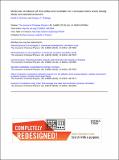| dc.contributor.author | Nicholson, David Andrew | |
| dc.contributor.author | Rutledge, Gregory C | |
| dc.date.accessioned | 2017-06-07T15:08:15Z | |
| dc.date.available | 2017-06-07T15:08:15Z | |
| dc.date.issued | 2016-12 | |
| dc.date.submitted | 2016-10 | |
| dc.identifier.issn | 0021-9606 | |
| dc.identifier.issn | 1089-7690 | |
| dc.identifier.uri | http://hdl.handle.net/1721.1/109703 | |
| dc.description.abstract | Non-equilibrium molecular dynamics is used to study crystal nucleation of n-eicosane under planar shear and, for the first time, uniaxial extension. A method of analysis based on the mean first-passage time is applied to the simulation results in order to determine the effect of the applied flow field type and strain rate on the steady-state nucleation rate and a characteristic growth rate, as well as the effects on kinetic parameters associated with nucleation: the free energy barrier, critical nucleus size, and monomer attachment pre-factor. The onset of flow-enhanced nucleation (FEN) occurs at a smaller critical strain rate in extension as compared to shear. For strain rates larger than the critical rate, a rapid increase in the nucleation rate is accompanied by decreases in the free energy barrier and critical nucleus size, as well as an increase in chain extension. These observations accord with a mechanism in which FEN is caused by an increase in the driving force for crystallization due to flow-induced entropy reduction. At high applied strain rates, the free energy barrier, critical nucleus size, and degree of stretching saturate, while the monomer attachment pre-factor and degree of orientational order increase steadily. This trend is indicative of a significant diffusive contribution to the nucleation rate under intense flows that is correlated with the degree of global orientational order in a nucleating system. Both flow fields give similar results for all kinetic quantities with respect to the reduced strain rate, which we define as the ratio of the applied strain rate to the critical rate. The characteristic growth rate increases with increasing strain rate, and shows a correspondence with the nucleation rate that does not depend on the type of flow field applied. Additionally, a structural analysis of the crystalline clusters indicates that the flow field suppresses the compaction and crystalline ordering of clusters, leading to the formation of large articulated clusters under strong flow fields, and compact well-ordered clusters under weak flow fields. | en_US |
| dc.language.iso | en_US | |
| dc.publisher | American Institute of Physics (AIP) | en_US |
| dc.relation.isversionof | http://dx.doi.org/10.1063/1.4972894 | en_US |
| dc.rights | Article is made available in accordance with the publisher's policy and may be subject to US copyright law. Please refer to the publisher's site for terms of use. | en_US |
| dc.source | MIT Web Domain | en_US |
| dc.title | Molecular Simulation of Flow-Enhanced Nucleation in n-Eicosane Melts Under Steady Shear and Uniaxial Extension | en_US |
| dc.type | Article | en_US |
| dc.identifier.citation | Nicholson, David A. and Rutledge, Gregory C. “Molecular Simulation of Flow-Enhanced Nucleation in n-Eicosane Melts Under Steady Shear and Uniaxial Extension.” The Journal of Chemical Physics 145, no. 24 (December 2016): 244903 © 2016 American Institute of Physics (AIP) | en_US |
| dc.contributor.department | Massachusetts Institute of Technology. Department of Chemical Engineering | en_US |
| dc.contributor.mitauthor | Nicholson, David Andrew | |
| dc.contributor.mitauthor | Rutledge, Gregory C | |
| dc.relation.journal | Journal of Chemical Physics | en_US |
| dc.eprint.version | Final published version | en_US |
| dc.type.uri | http://purl.org/eprint/type/JournalArticle | en_US |
| eprint.status | http://purl.org/eprint/status/PeerReviewed | en_US |
| dspace.orderedauthors | Nicholson, David A.; Rutledge, Gregory C. | en_US |
| dspace.embargo.terms | N | en_US |
| dc.identifier.orcid | https://orcid.org/0000-0002-9693-5219 | |
| dc.identifier.orcid | https://orcid.org/0000-0001-8137-1732 | |
| mit.license | PUBLISHER_POLICY | en_US |
